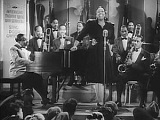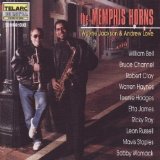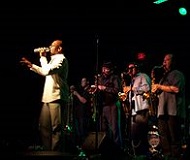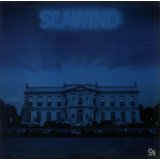Our next contributor plays saxophone with Southside Johnny and The Asbury Jukes but also released a strikingly good album this year as part of the New York Horns which is one of Allan’s albums of the year. When we asked him for a High Fives piece, here’s what he came up with. We think you’ll like this.
5 Horn Sections That Changed My Life
As a saxophone player, one of my absolute favorite ways to make music is with other horn players. Give me a trumpet or two, a couple of other saxophone players and a trombone to add some love, and you’ve got a recipe for a whole lotta fun. If the rhythm section is the meat and potatoes, and the vocalist is dessert, then the horn section is the salt. We bring out all the other flavors and make everything oh so much sweeter.
In thinking about the subject matter for this best-of list, it quickly dawned on me that I had MANY more than five examples that I could draw upon to make my point. So many that I almost gave up! After some careful consideration though, here’s five of the horn sections that have changed my life through their contributions to the music:
THE swingin-est band in the history of jazz. Count Basie’s band emerged in the 1930’s in Kansas City, and became the de facto definition of foot-stomping swing with their penchant for shouting blues, riffing head arrangements, and an infectious groove that just made you want to dance. The jazz traditions of “riffing” and “head arrangements”, while not originating with the Basie band, were certainly developed and forwarded onward by the band. Many of the riffs, licks and phrases that you will hear modern horn sections play can trace some or part of their lineage back to the Basie band. Check out “The Atomic Mr. Basie” (1957) and “Count Basie Swings, Joe Williams Sings” (1956). Two of my all time favorite Basie albums.
James Brown redefined popular music. He also redefined the role of the horn section in popular music. Prior to his influence, horns would generally have a more melodic role – playing melodies and generally being in a “lead” role. The late swing and early jump blues bands often were led by horn players and under the vocals the horns played a large supporting role, remaining a mostly harmonic underpinning. James changed all that. The horn section under James Brown became another rhythmic instrument, driving and propelling the groove. With snapping rhythmic pulses and repeating motifs, the horn section was another texture in the rhythm section, adding propulsion and rhythmic intensity. Check out “Mother Popcorn”, “Super Bad”, “Soul Power” and “Cold Sweat” for classic examples. The JB Horns (Maceo Parker, Fred Wesley, Alfred “Pee Wee” Ellis) also were a fixture of P-Funk and Bootsie’s (Collins) Rubber Band, as the Horny Horns.
Growing up in North Carolina, in the southern United States, it was inevitable that I was exposed to the music coming out of Memphis, Tennessee and especially STAX Records. Wayne Jackson and Andrew Love, aka the Memphis Horns, are one of the most recorded horn sections in history. If you’ve heard “Dock Of The Bay”, “Soul Man”, “Hold On I’m Comin’”, “Suspicious Minds”, “Sweet Caroline”, “Takin’ It To The Streets”, “Let’s Stay Together”, “Born Under A Bad Sign”, “Knock On Wood” (and countless other hits), then you’ve heard the Memphis Horns. They appeared on virtually every STAX recording, backing Otis Redding, Sam & Dave, Eddie Floyd, Carla & Rufus Thomas and an endless list of others. Not only were they a staple of the Memphis scene but could also be found as part of the Muscle Shoals scene, and on recordings with Aretha Franklin and Wilson Pickett.
No modern horn player that plays funk, soul or R&B hasn’t heard of or spent time studying TOP. Bursting onto the scene in Oakland, CA in 1968, Tower saw its peak success from 1973 to 1974. The band continues to tour extensively to this day, playing hundreds of shows every year across the world. The horn section has been featured on countless recordings by artists as diverse as Little Feat, Graham Central Station, The Monkees, Santana, Elton John, John Lee Hooker, Rufus, Rod Stewart, Huey Lewis and the News, and Aerosmith and has come to define a punchy, modern and funky style of writing and performing for horns. Check out “Tower of Power” (1973) and “Back to Oakland” (1974) for the definitive TOP experience.
While not a horn section unto himself, Jerry Hey has probably written more horn arrangements for hit songs and albums than anyone else in the business. As part of the Seawind Horns, Jerry was brought to the attention of Quincy Jones. That relationship led to Jerry’s writing for some of the biggest names in the industry. His credits as an arranger include albums from Michael Jackson, Brothers Johnson, Donna Summer, Rufus, George Benson, Patti Austin, James Ingram, Frank Sinatra, Barbra Streisand, Earth, Wind and Fire , Al Jarreau, Chaka Khan, and the list goes on… Two of my favorite albums that feature Jerry’s writing (and the Jerry Hey Horns) extensively are Al Jarreau’s “Jarreau” and “High Crime” (Check out “Imagination”!) and likely my all time favorite Jerry Hey arrangement (and performance) is from Michael Jackson’s “Workin’ Day And Night” (“Off The Wall”).
I could go on and on… there are so many great horn sections, players and writers out there, making incredible music. Hopefully this list will give you some food for thought and a good place to begin to explore the horn section legacy. Enjoy!
 St. Vincent’s star has been steadily rising for almost eight years. Each one of her three albums has surpassed the other for originality, songwriting ability and scorching self-possession. This, her fourth and the first to be self-titled (and appropriately at that), continues with that trend. Although it may not actually be better than some of 2011’s seductive and quietly threatening “Strange Mercy”, it is a more human and bolder work and marks the introduction of an unfiltered honesty that previous albums kept closer to their chest. She has taken both musical and physical elements of the biggest and most successful pop stars of the mid-eighties and early nineties – Madonna, Prince and Michael Jackson- and compressed them into an art rock template where David Bowie continues to dominate Annie Clark’s pop-cultured psyche. But then again the eponymous naming of the album adds credence and a confidence to the idea that this could only be a St Vincent album, every second of it could have only come from Annie Clark’s own pen, her lips and guitar.
St. Vincent’s star has been steadily rising for almost eight years. Each one of her three albums has surpassed the other for originality, songwriting ability and scorching self-possession. This, her fourth and the first to be self-titled (and appropriately at that), continues with that trend. Although it may not actually be better than some of 2011’s seductive and quietly threatening “Strange Mercy”, it is a more human and bolder work and marks the introduction of an unfiltered honesty that previous albums kept closer to their chest. She has taken both musical and physical elements of the biggest and most successful pop stars of the mid-eighties and early nineties – Madonna, Prince and Michael Jackson- and compressed them into an art rock template where David Bowie continues to dominate Annie Clark’s pop-cultured psyche. But then again the eponymous naming of the album adds credence and a confidence to the idea that this could only be a St Vincent album, every second of it could have only come from Annie Clark’s own pen, her lips and guitar.
A lot of the songs on “St. Vincent” are uncoded, straightforward story-telling songs relating to Clark’s own experiences. Some of the songs are harder to decipher and are more abstract and, on occasion, surreal. If there is an underlying theme here then it is how life is now for someone who has known what it is to be online for the majority of their adulthood but who has also experienced at the start of their childhood, pre-internet life. It is the outlook of someone who has therefore placed some (healthy?) distance to the option of only living a life continually attached to a screen of some size.
The opening track “Rattlesnake” and cloudily synthetic ballad “I Prefer Your Love”, which sits in the centre of the album and quite sensibly between two of the most frenzied and odd tracks, both fall into the first category of this vivid storytelling. The metallic and brittle shake of “Rattlesnake” recounts Clark’s walk through a seemingly deserted desert, how she removes all of her clothes due to the heat and a desire to be free and connect with both the moment and the surrounding nature. The sound and then appearance of a rattlesnake provokes a fight or flight sprint back to safety. This is a very loaded image or course, phallic maybe and certainly mythical and the raise in Clark’s vocal inflection towards the end – ‘I’m not the only one!’ – and the dryness of the rhythm helps bring to life both the thrill and the fear.
“I Prefer Your Love” really does wear its heart firmly on its sleeve. Annie Clark recently very nearly lost her mother to illness and with lines like ‘wipe the blush and smudge from my cheek and wonder what will be become of your little one’, this is a last lullaby for a child whose parent means more to them than any spiritual or religious figurehead could. There is no trickery with this track, it’s a beautiful song and although the rhythm and melody of the verses sound a little like the verses of “Ashes to Ashes” and it could easily be the missing song in a quartet of Patrick Leonard-written Madonna ballads, compared to Clark’s discography thus far it is surprising for its truthfulness and sincerity.
Following last year’s sometimes successful collaboration with David Byrne, the brass funk that dominated “Love This Giant” makes a brief reappearance on the exhilarating “Digital Witness”, a better and more memorable track than any that appeared on “Giant”. Along with the eccentric and genre shifting “Huey Newton”, this song explicitly questions the point of some social media and specially that of sharing information that really requires no further spectators and the reasons why such validation is required for just about everything. Liking another person’s status when that status tells you that they are in their garden? ‘If I you can’t show it, you can’t see me; what’s the point in doing anything?’ echoes Clark. “Digital Witness” is an example of the move, albeit subtle, to songs that are as catchy as can be, subversive lyrically still but brighter and bolder than before. In another lifetime it could have been a Kid Creole and The Coconuts track. The astounding “Huey Newton” which follows a sedated lo-if r’n’b first half suddenly breaks down irreconcilably into a guitar-led psychosis-fuelled second half, initiated by nights of winter time loneliness with only Google Search for company.
“Bring Me Your Loves” is probably the most outwardly and bracingly strange moment on “St. Vincent”. It has an addled and fevered sweat and atmosphere with marching drums, multi-tracked and obnoxious harmonies frustrated by the ‘I took you off your leash but I can’t make you heel’ predicament it finds itself in. The gradually building “Regret” is a throwback in some ways to the woozy and unstable 1960s Disney soundtrack style that dominated the “Actor” album and “Birth in Reverse”, although bold in its lyrical gaucheness (‘it just an ordinary day, take out the garbage, masturbate’) and fluid and spontaneous guitar playing is a good St Vincent song but certainly not a brilliant one.
Later on, “Psychopath” delivers a taut electro-pop number which has some lovely and riveting sonic touches around the ‘ahh, ahh,ahh-ahh ahh’ refrain with everything bar the beat dropping out immediately and unexpectedly after the song’s chorus and “Prince Johnny” swoons sarcastically with divine lyrical bite. Album closer “Severed Crossed Fingers” is quite probably Clark’s best song so far, certainly featuring her most soulful performance to date. 60s girl group swells, chiming bells and guts, spleens and missing fingers. It’s interesting that the silly, noodling introduction to the track almost tries to undermine the weightiness of the sentiment, as though it’s embarrassed by its power. But its double bluff only really goes to show that St Vincent also acknowledges the absurdity that can accompany such grand gestures, that it is all still just an act and that sometimes there really is no hope left.
This is not the album with disco sounds and influences that many claim it to be (partly fuelled by St. Vincent’s description of the material herself before its release). You can dance to it, yes, but probably in the same robo-mannequin moonwalk style that Clarke herself has adopted during recent live shows. The full but still sometimes disconcertingly skeletal sound that is so intrinsically hers remains and has been honed to perfection here and the on-going production by John Congleton (previous collaborations tellingly include both Anna Calvi and Erykah Badu) is typically sharp and flawless. It seems unrealistic to expect her to stay in this role which is her most defined and confident thus far for long but for now St. Vincent has delivered her most accessible, easy to relate to, and consistently engaging and sparky album to date; if you haven’t experienced her yet then “St Vincent” is an excellent place to start.







